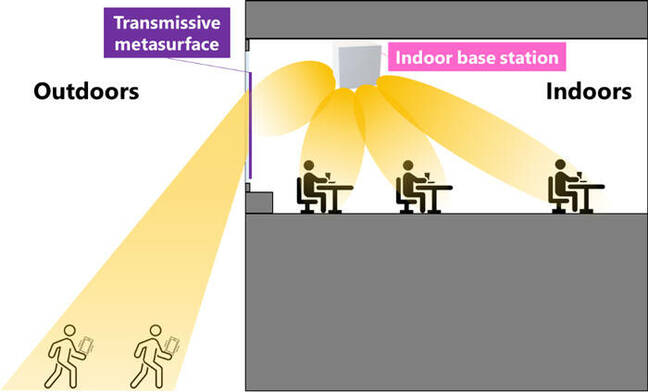Japan's NTT Docomo Uses Invisibility Cloak Tech To Fix 5G Reception
Japanese mobile operator NTT Docomo has opened up on its endeavors to make sure 5G and successor wireless technology generations continue to function, despite humans – or perhaps the companies that employ them – insisting they work indoors.
Windows and other elements of modern buildings are hostile to the high frequency radio waves used to carry signals from smartphones and other wireless kit.
This is why texting in an elevator doesn't work.
Higher wave frequency brings on increased signal attenuation and so the problem is only expected to get worse as humans progress from 5G into 6G.
The Japanese mobile giant reckons the solution is modified windows. It has therefore explored two new approaches to fenestration – the art of window design.
The first involves changing the material within the window. NTT teamed up with American window manufacturer YKK AP to launch a test of an aerogel-infused signal permeable window prototype.
- Toyota reveals its work on an honest-to-goodness cloak of invisibility
- China stops recognizing online study, orders kids back to foreign unis
- Humans may be able to live on Mars within halls of aerogel – a wonder material that can trap heat and block radiation
- European telco body looks into terahertz for future 6G comms
Aerogel – the dried up substance made from removing liquid from a gel resulting in an ultralight, super porous, heat-trapping material – has long been used in spacesuits and other NASA applications.
According to Docomo, since aerogel has a dielectric constant close to air, it allows radio waves to penetrate easily.
"The demonstration will enable Docomo to test materials, shapes and window structures that best allow radio waves to pass through," said the telco.
Docomo added that it will continue to research radio-penetrable windows, with the ultimate goal to install improved designs both in ceilings and walls of existing and new homes and offices.
For its other window design change, the mobile operator trialed transmissive metasurface technology at its Yokosuka R&D center. The technology incorporates a layer on the window surface that bends radio waves and aims them at places where people will need them.
The layer Docomo used contains arrays of subwavelength-spaced optical scatterers that change the path of passing waves. The technology has been adopted on other surfaces by Kyocera to enhance 5G and car manufacturer Toyota to devise – not joking – an invisibility cloak.
Docomo said it may be possible to direct signals from a 5G indoor base station to a glass window's transmissive metasurface to improve coverage.
"Also, in the future, when constructing a massive multiple-input multiple-output (MIMO) system that uses much larger number of antennas, it may be possible to achieve an equivalently large-scale configuration with a relatively small number of antennas at a low cost by applying metasurface technology," prognosticated the communications behemoth.
All of which may one day be appreciated by organizations that need to deploy ever-larger numbers of wireless transmitters to cope with increased reliance on Wi-Fi, the rise of private 5G, and whatever else comes next. ®
From Chip War To Cloud War: The Next Frontier In Global Tech Competition
The global chip war, characterized by intense competition among nations and corporations for supremacy in semiconductor ... Read more
The High Stakes Of Tech Regulation: Security Risks And Market Dynamics
The influence of tech giants in the global economy continues to grow, raising crucial questions about how to balance sec... Read more
The Tyranny Of Instagram Interiors: Why It's Time To Break Free From Algorithm-Driven Aesthetics
Instagram has become a dominant force in shaping interior design trends, offering a seemingly endless stream of inspirat... Read more
The Data Crunch In AI: Strategies For Sustainability
Exploring solutions to the imminent exhaustion of internet data for AI training.As the artificial intelligence (AI) indu... Read more
Google Abandons Four-Year Effort To Remove Cookies From Chrome Browser
After four years of dedicated effort, Google has decided to abandon its plan to remove third-party cookies from its Chro... Read more
LinkedIn Embraces AI And Gamification To Drive User Engagement And Revenue
In an effort to tackle slowing revenue growth and enhance user engagement, LinkedIn is turning to artificial intelligenc... Read more


